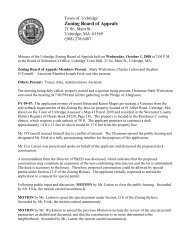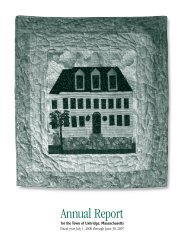FY 2011 - Town of Uxbridge
FY 2011 - Town of Uxbridge
FY 2011 - Town of Uxbridge
You also want an ePaper? Increase the reach of your titles
YUMPU automatically turns print PDFs into web optimized ePapers that Google loves.
Superintendent’s<br />
Report continued<br />
The school year ended with the<br />
retirement <strong>of</strong> Dr. Howard Boyaj. Dr Boyaj<br />
served for many years as Whitin Middle<br />
School Principal, Curriculum Director,<br />
Interim Superintendent and most<br />
recently, Taft Elementary School<br />
Principal. We wished him the best for a<br />
healthy and lengthy retirement.<br />
The <strong>Uxbridge</strong> Public Schools<br />
served 1,957 students, following our<br />
mission to provide challenging<br />
educational programs and services to<br />
meet the diverse needs <strong>of</strong> all students in<br />
a safe, supportive environment and, in<br />
partnership with the community, prepare<br />
students to become competent, creative,<br />
and contributing citizens.<br />
Throughout the year the staff<br />
worked to accomplish the goals as<br />
outlined in the Strategic Plan. These<br />
goals focused on areas <strong>of</strong> Curriculum,<br />
Instruction, and Assessment, School<br />
Climate and Culture, Technology, and<br />
Family and Community. We have<br />
continued to apply rigorous and<br />
comprehensive curriculum and<br />
appropriate instructional techniques in<br />
order to challenge students to discover<br />
and develop their strengths, talents, and<br />
interests for maximum student<br />
achievement. In addition, we continually<br />
embrace the involvement <strong>of</strong> our parents<br />
and our community members, as they<br />
are a large component in our student’s<br />
success.<br />
Included in this report you will see<br />
information from each building, which<br />
highlights new programs for the 2010-<br />
<strong>2011</strong> school year as well as existing<br />
programs which we were able to provide<br />
for our students.<br />
Respectfully Submitted,<br />
George Zini<br />
Superintendent <strong>of</strong> Schools<br />
Taft Elementary<br />
School<br />
Taft School houses approximately<br />
600 students in Grades 1 – 4. Current<br />
administration includes Dr. Howard<br />
Boyaj, Principal and Lori Fafard,<br />
Assistant Principal. There are 29<br />
classroom teachers and additional<br />
support staff. Children receive a rich<br />
education which includes weekly art,<br />
music, physical education, computer and<br />
library classes. Some <strong>of</strong> the programs<br />
and activities held throughout the year<br />
include:<br />
Curriculum and Instruction<br />
Programs<br />
Story<strong>Town</strong> Reading<br />
The Story<strong>Town</strong> reading and<br />
language arts program, developed by<br />
Harcourt School Publishers, has been<br />
adopted for students in grades K-6 in<br />
<strong>Uxbridge</strong> Public Schools. This is the<br />
second year in use. Story<strong>Town</strong> features<br />
an organized direct approach to teaching<br />
reading that is aligned with the<br />
Massachusetts State Curriculum<br />
Frameworks. The program emphasizes<br />
explicit, systematic instruction in the five<br />
essential components <strong>of</strong> reading that<br />
include phonemic awareness, phonics,<br />
vocabulary, fluency and comprehension.<br />
The development <strong>of</strong> Harcourt’s<br />
Story<strong>Town</strong> is the result <strong>of</strong> extensive and<br />
confirmed research that is based on best<br />
instructional practice in the teaching <strong>of</strong><br />
reading.<br />
Following are several key<br />
components <strong>of</strong> the program: A highquality<br />
collection <strong>of</strong> classic and<br />
contemporary literature designed to<br />
foster a love <strong>of</strong> reading in school and at<br />
home; three tiers <strong>of</strong> intervention<br />
strategies, targeted materials, and<br />
classroom management tools that match<br />
instruction to meet the different needs <strong>of</strong><br />
students; integrated language arts<br />
lessons planned to help students<br />
develop and practice writing forms,<br />
grammar, usage, mechanics, and<br />
spelling skills; a program <strong>of</strong> various<br />
assessments to ensure mastery or<br />
diagnosis <strong>of</strong> reading difficulties<br />
throughout the year.<br />
DORA<br />
During the 2010-<strong>2011</strong> school year,<br />
teachers at Taft implemented the<br />
Diagnostic Online Reading Assessment<br />
(DORA) three times a year as part <strong>of</strong> the<br />
reading assessment protocol. “DORA is a<br />
comprehensive, valid, and reliable webbased<br />
assessment that diagnostically<br />
assesses children’s reading abilities.” The<br />
assessment is interactive, and adapts as<br />
students’ respond to each question, getting<br />
harder or easier as needed to complete the<br />
test. The student interface is in a cartoon<br />
style, and makes testing fun and engaging.<br />
DORA measures eight sub-skills <strong>of</strong><br />
reading: high-frequency words, word<br />
recognition, phonics, phonemic awareness,<br />
oral vocabulary, spelling, reading<br />
comprehension and fluency. By examining<br />
multiple reading measures together, DORA<br />
reveals each student’s unique reading<br />
pr<strong>of</strong>ile; providing teachers with invaluable<br />
information for driving instruction.<br />
Response to Intervention<br />
Since the beginning <strong>of</strong> the year the<br />
kindergarten through fourth grade teachers<br />
have been implementing Response to<br />
Intervention (RTI). RTI is a three tiered<br />
approach to education in which a student’s<br />
academic performance is closely monitored<br />
to see if he or she improves with the<br />
implementation <strong>of</strong> a, “well-defined,<br />
scientifically based intervention.” In reality,<br />
RTI effects <strong>of</strong> all our students here at Taft<br />
and ELC since the first tier deals with a<br />
school’s core academic program. It<br />
specifies that the core program be a high<br />
quality, scientifically based program, which<br />
our reading series Story<strong>Town</strong> is. Tier I also<br />
includes the differentiation <strong>of</strong> instruction,<br />
which means that teachers and specialists<br />
work together to present this core material<br />
in different formats so that the content is<br />
accessible to all <strong>of</strong> our students. Thus<br />
giving every student equal access to highquality<br />
education.<br />
Tier II <strong>of</strong> RTI addresses 15% <strong>of</strong> a<br />
school’s students, and adds targeted<br />
intervention to the Tier I instruction, based<br />
on students’ needs. Progress in the<br />
intervention is closely monitored to see if a<br />
child’s performance improves, or further<br />
interventions are necessary. Tier III <strong>of</strong> the<br />
RTI model targets 5% <strong>of</strong> a school’s<br />
population and includes all <strong>of</strong> the core<br />
Page 44<br />
<strong>FY</strong> <strong>2011</strong> :: <strong>Town</strong> <strong>of</strong> <strong>Uxbridge</strong> Annual Report





